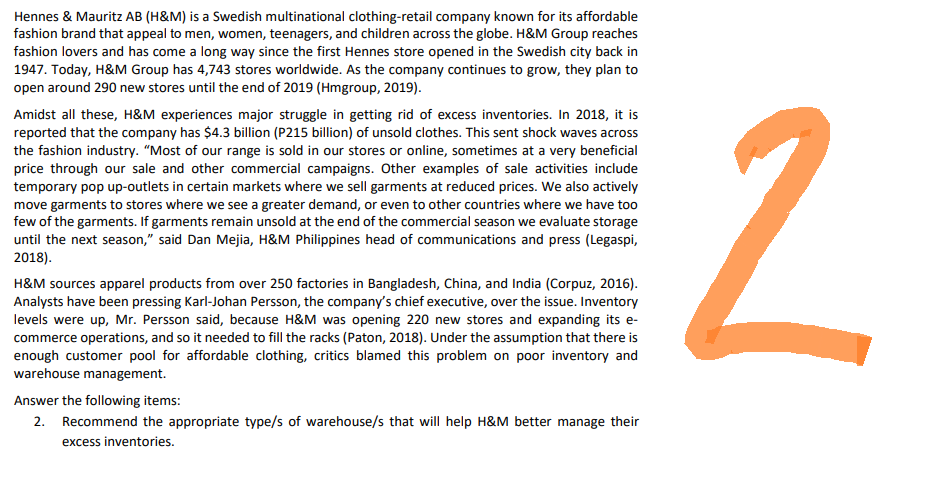Answer the following items: 2. Recommend the appropriate type/s of warehouse/s that will help H&M better manage their excess inventories.
Answer the following items: 2. Recommend the appropriate type/s of warehouse/s that will help H&M better manage their excess inventories.
Chapter14: Marketing Channels And Supply Chain Management
Section14.2: Procter & Gamble Tunes Up Channels And Transportation
Problem 2C
Related questions
Question
100%
TYPEWRITTEN ONLY PLEASE. ILL UPVOTE ONLY IF TYPEWRITTEN, COMPLETE, AND CORRECT. DONT ANSWER IF YOU ALREADY ANSWERED THIS, ILL DOWNVOTE. THANK YOU

Transcribed Image Text:Hennes & Mauritz AB (H&M) is a Swedish multinational clothing-retail company known for its affordable
fashion brand that appeal to men, women, teenagers, and children across the globe. H&M Group reaches
fashion lovers and has come a long way since the first Hennes store opened in the Swedish city back in
1947. Today, H&M Group has 4,743 stores worldwide. As the company continues to grow, they plan to
open around 290 new stores until the end of 2019 (Hmgroup, 2019).
Amidst all these, H&M experiences major struggle in getting rid of excess inventories. In 2018, it is
reported that the company has $4.3 billion (P215 billion) of unsold clothes. This sent shock waves across
the fashion industry. "Most of our range is sold in our stores or online, sometimes at a very beneficial
price through our sale and other commercial campaigns. Other examples of sale activities include
temporary pop up-outlets in certain markets where we sell garments at reduced prices. We also actively
move garments to stores where we see a greater demand, or even to other countries where we have too
few of the garments. If garments remain unsold at the end of the commercial season we evaluate storage
until the next season," said Dan Mejia, H&M Philippines head of communications and press (Legaspi,
2018).
H&M sources apparel products from over 250 factories in Bangladesh, China, and India (Corpuz, 2016).
Analysts have been pressing Karl-Johan Persson, the company's chief executive, over the issue. Inventory
levels were up, Mr. Persson said, because H&M was opening 220 new stores and expanding its e-
commerce operations, and so it needed to fill the racks (Paton, 2018). Under the assumption that there is
enough customer pool for affordable clothing, critics blamed this problem on poor inventory and
warehouse management.
Answer the following items:
2. Recommend the appropriate type/s of warehouse/s that will help H&M better manage their
excess inventories.
2
Expert Solution
This question has been solved!
Explore an expertly crafted, step-by-step solution for a thorough understanding of key concepts.
Step by step
Solved in 2 steps

Recommended textbooks for you

